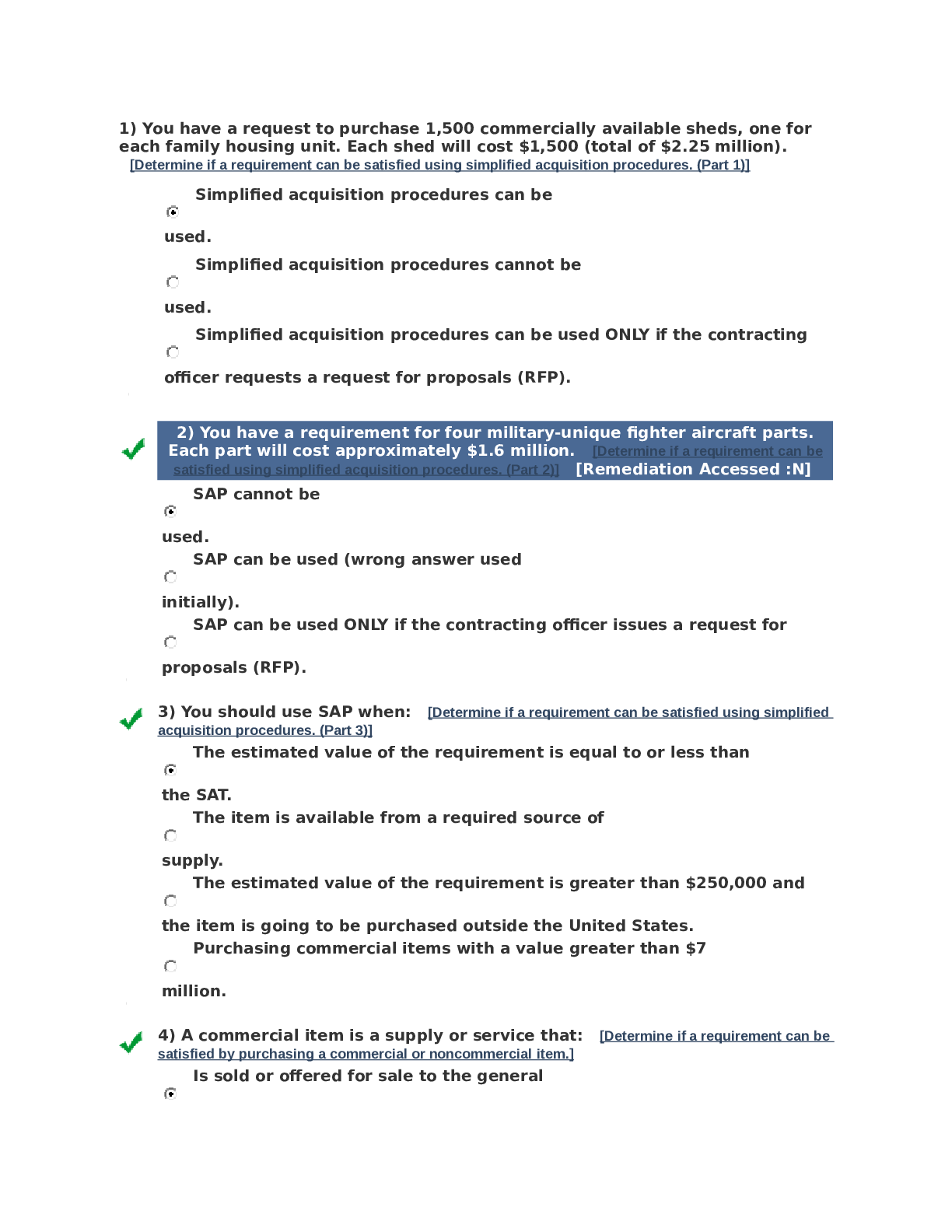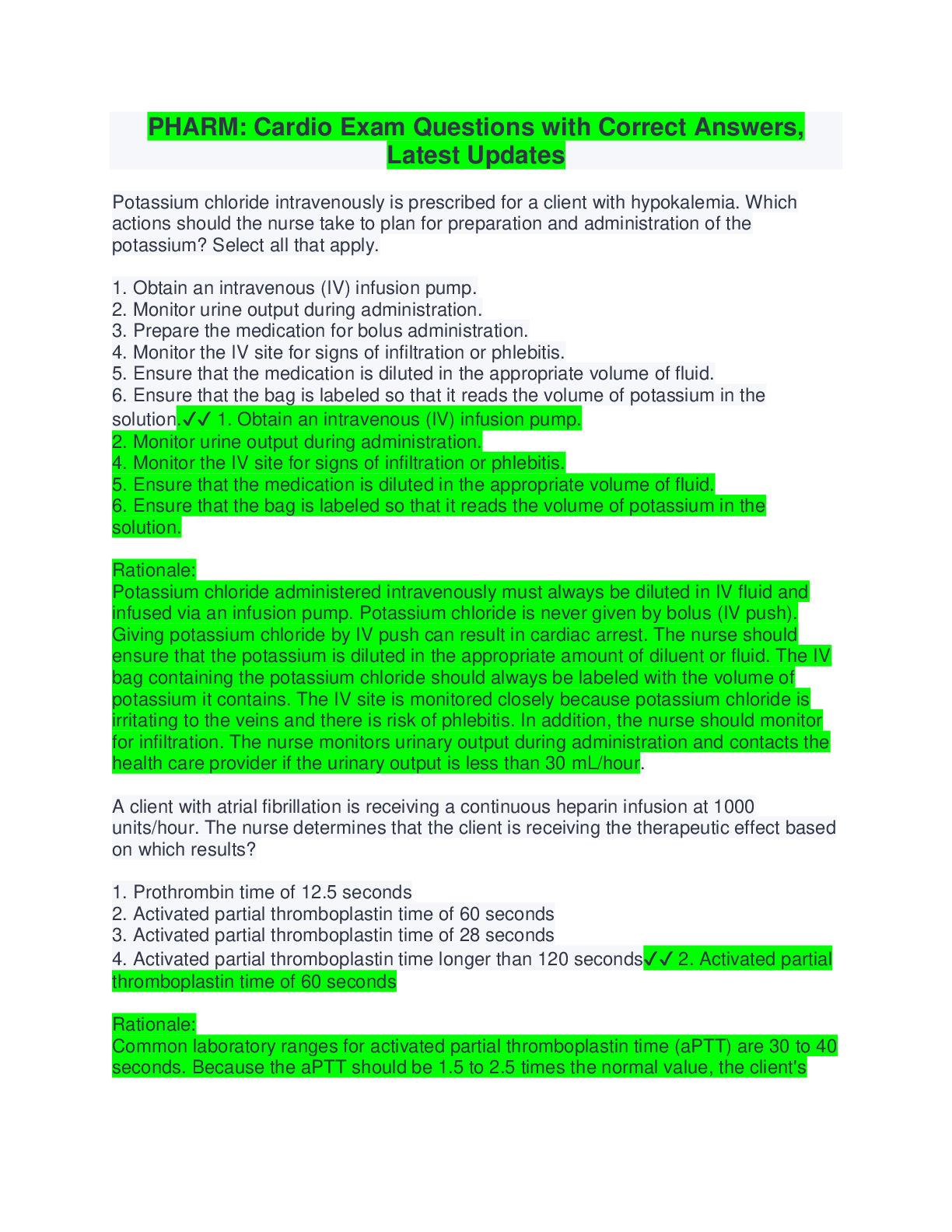BioChemistry > QUESTIONS & ANSWERS > 171 Biochemistry Exam 1 Questions with correct answers 2022/2023 (All)
171 Biochemistry Exam 1 Questions with correct answers 2022/2023
Document Content and Description Below
171 Biochemistry Exam 1 Questions with correct answers 2022/2023 Myoglobin >>What protein is used for storage? Myoglobin Hemoglobin Collagen Transferrin It's a covalent interaction >>What is NO... T TRUE of antibodies with respect to protection? It is a covalent interaction It's a noncovalent interaction; hydrogen bonding Aspartic acid pKa=3.9 >>What is the amino acid that would dissociate a proton and make it ionizable in physiological pH? Aspartic acid pKa= 3.9 Histidine pKa= 6 Lysine Planar >>What is the configuration of a peptide bond? Peptide bonds need to be intact >>What do you have to have to make a protein denaturation reversible? Peptide bond needs to be intact Hydrogen bonds Disulfide Bonds Quaternary structure KEY WORD: SUBUNITS >>What is the spatial arrangement of amino acids and functional subunits? Tertiary structure Primary structure Secondary structure Quaternary structure Primary structure >>Which structure is predominantly responsible for a protein's 3D structure of amino acids and provides protein with function? Primary structure Secondary structure Tertiary structure Quaternary structure Insulation >>What is NOT considered one of the characteristics of amino acids? SupportProtection Insulation High binding affinity Deprotonated, Protonated >>In the amino acid structure, the carboxylic group is ___ and the amino group is ___. Protonated, Deprotonated Deprotonated, Protonated As pH decreases, the charge will become negative >>What is NOT TRUE of the pH and charge complementarity? Changes in charge affects protein function. As pH decreases, the charge will become negative As pH decreases, the charge will become more positive As pH increases, the charge will become more negative. Hydrophobic >>The interior of the protein is? None of these Hydrophobic Polar Glutamic acid >>What is the amino acid at the N-terminus, EGAK? Lysine Glutamic Acid Disulfide bonds >>What covalent interaction is the primary structure of proteins stabilized by? Hydrogen Bonding Ionic interactions Van der Waals Disulfide Bonds Phenylalanine, Tyrosine >>What 2 amino acids are considered aromatic? Hemoglobin >>What contains a quaternary protein structure? -1/km >>The x axis of a Lineweaver Burk plot is? • -1/km • Km • Vmax • The effect is facilitated by more oxygen binding >>The positive cooperativity of oxygen and hemoglobin is best described as • The effect is facilitated by more oxygen binding • Oxygen has no effect • Oxygen affinity decreasesMethotrexate >>The reversible inhibitor in this group is? • Methotrexate • Cyanide • Organophosphates • Km is increased and Vmax is unchanged >>In Competitive inhibition, what happens to the Km and Vmax? • Km is increased and Vmax is unchanged • Km is decreased and Vmax is unchanged • Km and Vmax are both decreased • Km and Vmax are both increased • Km is unchanged Vmax is reduced >>In Noncompetitive inhibition, what happens to the Km and Vmax? • Km is unchanged Vmax is reduced • Vmax is increased and Km is unchanged • Km and Vmax are both decreased • Km and Vmax are both unchanged Would reduce the inhibitor action. >>Adding substrate in Competitive inhibition • Would reduce the inhibitor action. • Would enhance the inhibitor action. • Would have no effect on the inhibitor action. Inactive lacking a cofactor >>The definition of an apoenzyme is? • Inactive lacking a cofactor • Active lacking a cofactor • Inactive with a cofactor • Active with a cofactor The substrate concentration of ½ vmax >>Km is defined as • The substrate concentration of ½ vmax • ½ Vmax • Substrate concentration of Vmax • Substrate concentration Protein kinases >>The attachment of phosphoryl groups is by • Protein kinases • Protein phosphatases Zero kinetic order >>At high [S], what reaction order are you in? • Zero kinetic order • 1st Kinetic order • Subtrate has no effect on reaction orderIrreversible inhibitor >>Organophosphates are considered what kind of inhibitor? • Irreversible inhibitor • Reversible inhibitor • Natural irreversible inhibitor • Competitive inhibitor • Reversible binds noncovalently and irreversible binds covalently >>The difference between reversible and irreversible is? • Reversible binds noncovalently and irreversible binds covalently • Reversible binds covalently and irreversible binds noncovalently • If a reaction will be endergonic, exergonic, or equilibrium >>Gibbs free energy best demonstrates • If a reaction will be endergonic, exergonic, or equilibrium • A negative entropy • A positive temperature Ligase >>The reaction A + B -> AB is best described as a? • Ligase • Lyase • Transferase • Hydrolase • Lowers the activation energy and facilitates the reaction to proceed >>The enzyme in a reaction? Galactose >>1. Which of the following is an example of a monosaccharide? a. Galactose b. Sucrose c. Lactose d. Maltose Maltose >>2. Which of the following is an example of a disaccharide? a. Glucose b. Fructose c. Galactose d. Maltose Homoglycan >>3. When all the monosaccharides in a polysaccharide are of the same type, such a type of a polysaccharide is called a? a. Glycogen b. Homoglycan c. Heteroglycan d. Oligosaccharide Starch >>4. In which of the following forms is glucose stored in plants?a. Glycogen b. Starch c. Dextrin d. Cellulose Glycogen >>5. In which of the following forms is glucose stored in the liver? a. Glycogen b. Starch c. Dextrin d. Cellulose Glycogen >>6. Which of the following is analogous to starch? a. Cellulose b. Glycogen c. Sucrose d. Chitin Hexokinase >>7. Which of the following enzyme catalyzes the first step of glycolysis? a. Hexokinase b. Pyruvate Kinase c. Glucokinase d. Phosphofructokinase I Fermentation >>8. The general term used for the anaerobic degradation of glucose to obtain energy is? a. Anabolism b. Oxidation c. Fermentation d. Metabolism Phosphofructokinase 1 (It is a regulatory enzyme and a major point of regulation) >>9. Whenever the cell's ATP supply is depleted, which of the following enzyme's activity is increased? a. Hexokinase b. Pyruvate kinase c. Glucokinase d. Phosphofructokinase I c. An aldose and a ketose (Glyceraldehyde 3-phosphate & dihydroxyacetone phosphate) >>10. Cleavage of Fructose 1,6-biphosphate yields a. Two aldoses b. Two ketoses c. An aldose and a ketose (Glyceraldehyde 3-phosphate & dihydroxyacetone phosphate) d. Only a ketoseb. Oxidation of glyceraldehyde 3-phosphate to 1,3-biphosphoglycerate >>11. The first step in the payoff phase of glycolysis is? a. Reduction of 1,3-biphosphoglycerate to glyceraldehyde 3-phosphate b. Oxidation of glyceraldehyde 3-phosphate to 1,3-biphosphoglycerate c. Reversible conversion of dihydroxyacetone phosphate to glyceraldehyde 3- phosphate d. Irreversible conversion of dihydroxyacetone phosphate to glyceraldehyde 3- phosphate Hexokinase >>12. High concentration of glucose 6-phosphate is inhibitory to? a. Hexokinase b. Pyruvate kinase c. Glucokinase d. Phosphofructokinase I 3-phosphoglycerate >>13. The product formed in the first substrate level phosphorylation in glycolysis is? a. Pyruvate b. 3-phosphoglycerate c. 1,3-biphosphoglycerate d. 2-phosphoglycerate Glucose into pyruvate >>14. Glycolysis converts? a. Glucose into pyruvate b. Glucose into phosphoenolpyruvate c. Fructose into pyruvate d. Fructose into phosphoenolpyruvate Pyruvate dehydrogenase >>15. Enzyme involved in the pathway of synthesis of acetylCoA a. Hexokinase b. Pyruvate decarboxylase c. Pyruvate dehydrogenase d. Pyruvate kinase NAD+ >>16. In the reduction of pyruvate to lactate, which of the following is regenerated? a. H+ b. NADH c. NAD+ d. Na+ Gluconeogenesis >>17. When blood sugar levels fall, glycolysis is halted in liver to allow? a. Homeostasis b. Anaerobic respirationc. Aerobic respiration d. Gluconeogenesis It is stimulated by AMP and ADP >>18. Which of the following statements is true about PFK-1? a. It is stimulated by AMP and ADP b. It is stimulated by citrate and ATP c. It is inhibited by AMP and ADP d. It is stimulated by citrate and ADP a. From the hydrolysis of tri-acyl-glycerol, fatty acids can be used as a carbon source >>1. Which of the following statements is FALSE about gluconeogenesis? a. From the hydrolysis of tri-acyl-glycerol, fatty acids can be used as a carbon source. b. From red blood cells, lactate can be used as a carbon source c. From the hydrolysis of tri-acyl-glycerol, glycerol is converted to glucose in gluconeogenesis d. From muscle vigorous muscle activity, lactate can be used as a carbon source Malate dehydrogenase >>2. Oxaloacetate is reduced to malate by a. Pyruvate carboxylase b. Malate dehydrogenase c. Pyruvate kinase d. Phosphofructokinase-1 Pyruvate to glucose >>3. Gluconeogenesis involves conversion of a. Glucose to pyruvate b. Pyruvate to glucose c. Phosphoenolpyruvate to glucose d. Pyruvate to fructose a. 4 ATP, 2 GTP, and 2 NADH >>4. Formation of one molecule of glucose from pyruvate requires a. 4 ATP, 2 GTP, and 2 NADH b. 3 ATP, 2 GTP, and 2NADH c. 4 ATP, 1 GTP, 2 NADH d. 2 ATP, 2 GTP, and 2 NADH Alanine >>5. The main source of glucose carbons for glucose carbons for gluconeogenesis is a. Guanine b. Alanine c. Cysteine d. Threonine c. Glucose-6-phosphatase hydrolyzes glucose 6-phosphate to release glucose into the blood >>6. Which of the following statements about gluconeogenesis is correct?a. Pyruvate is first converted to phosphoenolpyruvate by phosphoenolpyruvate b. Fructose 1,6-biphosphatase converts fructose 1,6-biphosphate into fructose c. Glucose-6-phosphatase hydrolyzes glucose 6-phosphate to release glucose into the blood d. Glucose 6-phosphatase hydrolyzes glucose 6-phosphate and is found in liver and muscle True >>7. Anaerobic glycolysis can produce ATP at a much faster rate than aerobic oxidative phosphorylation. a. True b. False Aldol condensation >>8. Which of the following types of reaction does NOT occur in glycolysis? a. Isomerization b. Nucleophilic attack c. Aldol condensation d. Oxidation e. Dehydration Three strongly exergonic, nonequilibrium reactions >>9. Glycolysis is regulated primarily by: a. The availability of glucose-6-phosphate b. Three strongly endergonic, nonequilibrium reactions c. Three strongly exergonic, nonequilibrium reactions d. Allosteric effectors of pyruvate kinase e. Phosphorylation of phosphofructokinase e. ATP decreases the Km for its substrate fructose-6-phosphate >>10. Which of the following statements about regulation of phosphofructokinase is FALSE? a. AMP is an activator b. ADP is an activator c. Citrate is an inhibitor d. Fructose 2,6-biphosphate is an activator e. ATP decreases the Km for its substrate fructose-6-phosphate False >>11. All of the reactions of both glycolysis and gluconeogenesis occur in the cytosol. a. True b. False False >>12. The flux rate through the gluconeogenic pathway is directly proportional to the amount of carbohydrate in the diet. a. True b. FalseTrue >>13. Much of the regulation of gluconeogenesis is a result of the inhibition of glycolysis. a. True b. False Leucine >>14. Which of the following cannot be used as a precursor for gluconeogenesis? a. Glycerol b. Pyruvate c. Lactate d. Leucine e. Alanine Liver >>15. The primary gluconeogenic organ in animals is: a. Skeletal muscle b. Kidney medulla c. Kidney cortex d. Liver e. Heart muscle Lactate >>16. ____ from muscle working anaerobically is released to blood and can be taken up by liver where it is converted to pyruvate by the enzyme lactate dehydrogenase. a. Lactate b. Pyruvate c. Glucose True >>Both glycolysis and gluconeogenesis are controlled by fructose-2,6-biphosphate in response to hormones. a. True b. False True >>Glycogen is a major energy source for skeletal muscle contraction a. True b. False Hormonal control >>Gluconeogenesis responds to which of the following? a. Hormonal control b. pH control c. Temperature control d. Blood control Gluconeogenesis >>When blood sugar levels fall, glycolysis is halted in liver to allow a. Homeostasis b. Anaerobic respiration c. Aerobic respirationd. Gluconeogenesis 7 >>How many steps are catalyzed by same enzymes in both glycolysis and gluconeogenesis? a. 6 b. 7 c. 8 d. 9 3 >>22. How many steps are catalyzed by different enzymes in glycolysis and gluconeogenesis? a. 2 b. 3 c. 4 d. 5 Stimulated by AMP and ADP >>23. Which of the following statements is true about PFK-1? a. It is stimulated by AMP and ADP b. It is stimulated by citrate and ATP c. It is inhibited by AMP and ADP d. It is stimulated by citrate and ADP Fructose 2,6-biphosphate >>24. Which of the following is a potent regulator of glycolysis and gluconeogenesis? a. Fructose 2,6-biphosphate b. Fructose 1,6-biphosphate c. Fructose 6-phosphate d. Glucose 1,6-biphosphate Muscle phosphorylase >>1. McArdle's disease is due to the deficiency of? a. Glucose-6-phosphatase b. Phosphofructokinase c. Liver phosphorylase d. Muscle phosphorylase All of the above >>2. Uridine diphosphate glucose (UDPG) is? a. Required for metabolism of galactose b. Required for synthesis of glucuronic acid c. A substrate for glycogen synthase d. All of the above c. Protein primer for glycogen synthesis >>3. Glycogenin is? a. An uncoupler of oxidative phosphorylation b. Polymer of glycogen molecules [Show More]
Last updated: 1 year ago
Preview 1 out of 25 pages
Instant download

Instant download
Reviews( 0 )
Document information
Connected school, study & course
About the document
Uploaded On
Sep 18, 2022
Number of pages
25
Written in
Additional information
This document has been written for:
Uploaded
Sep 18, 2022
Downloads
0
Views
22
















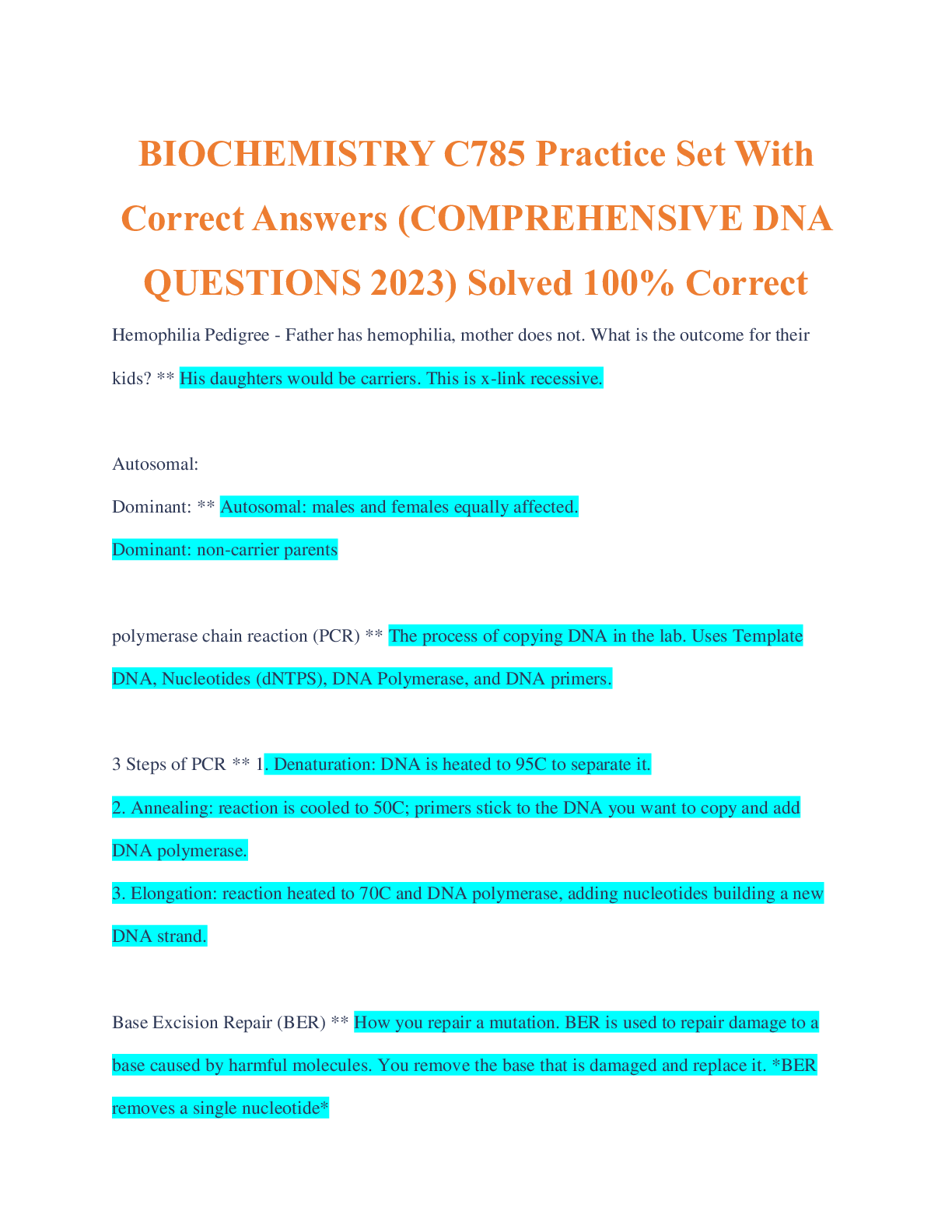
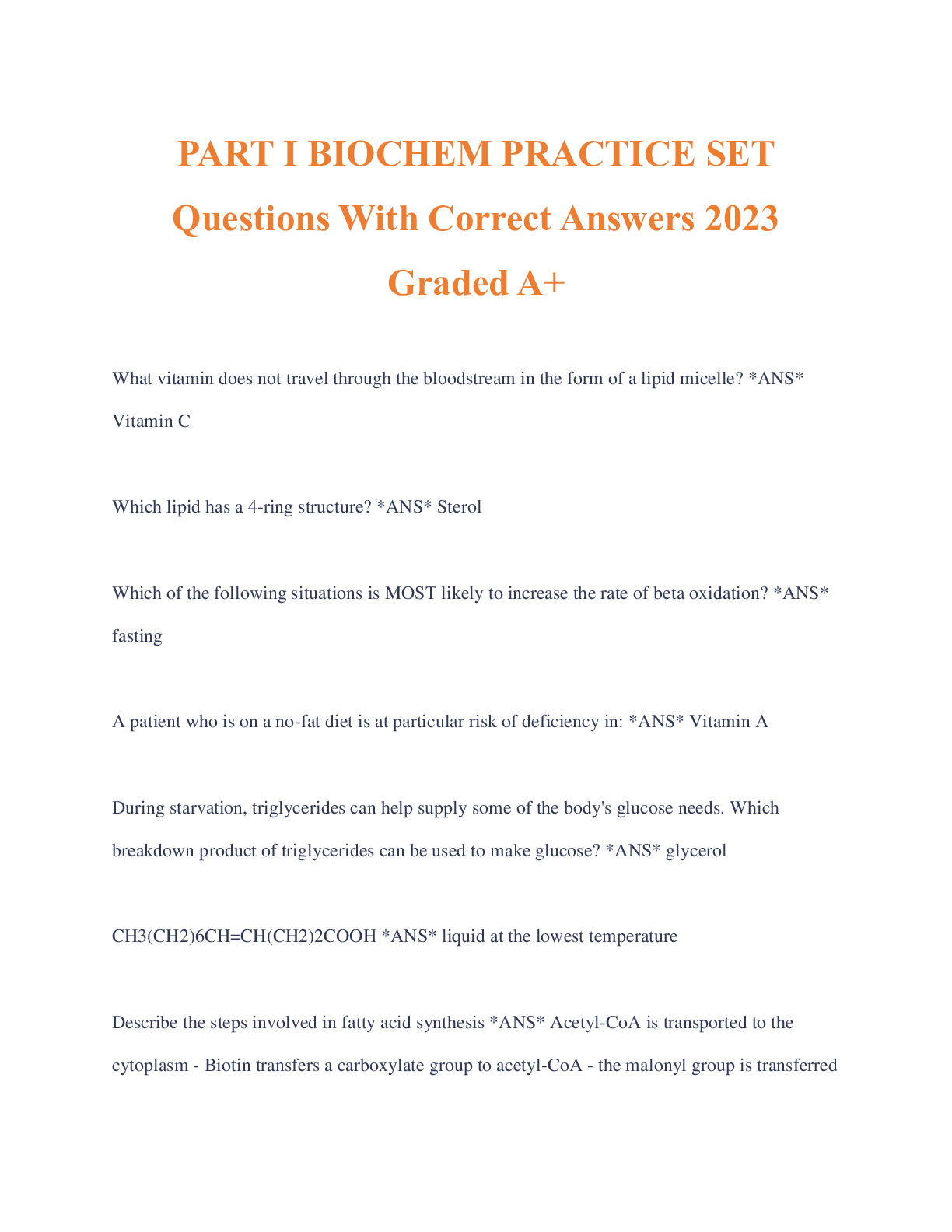
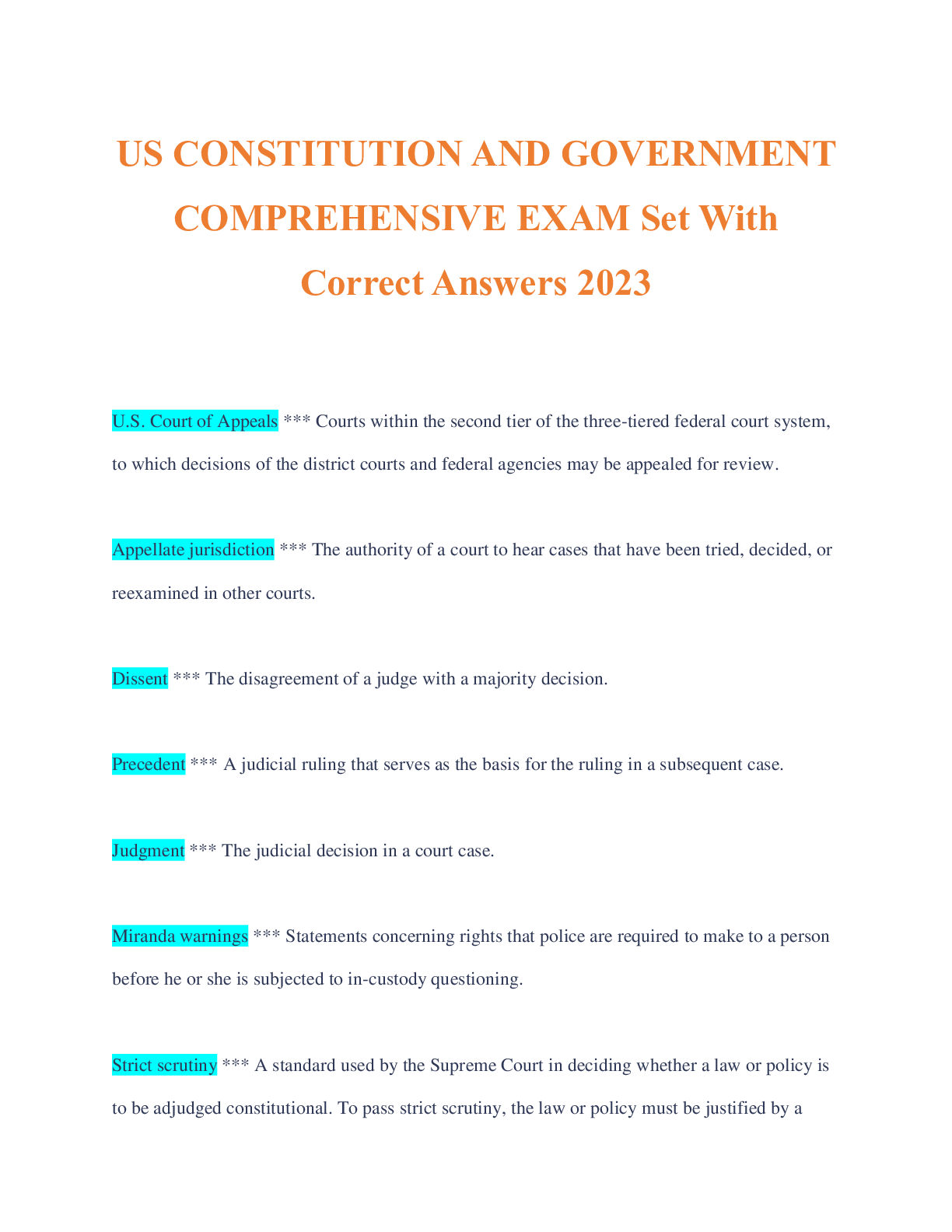
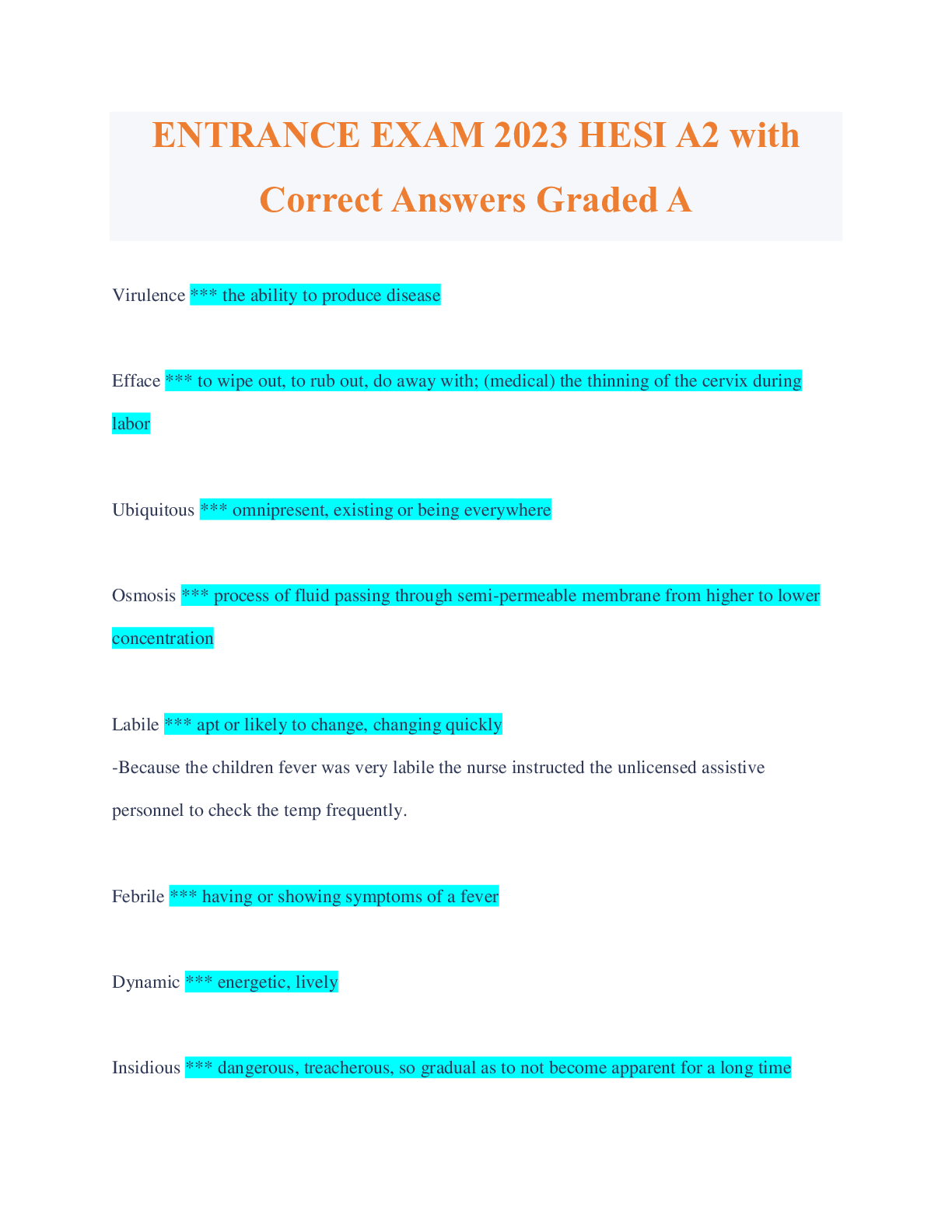


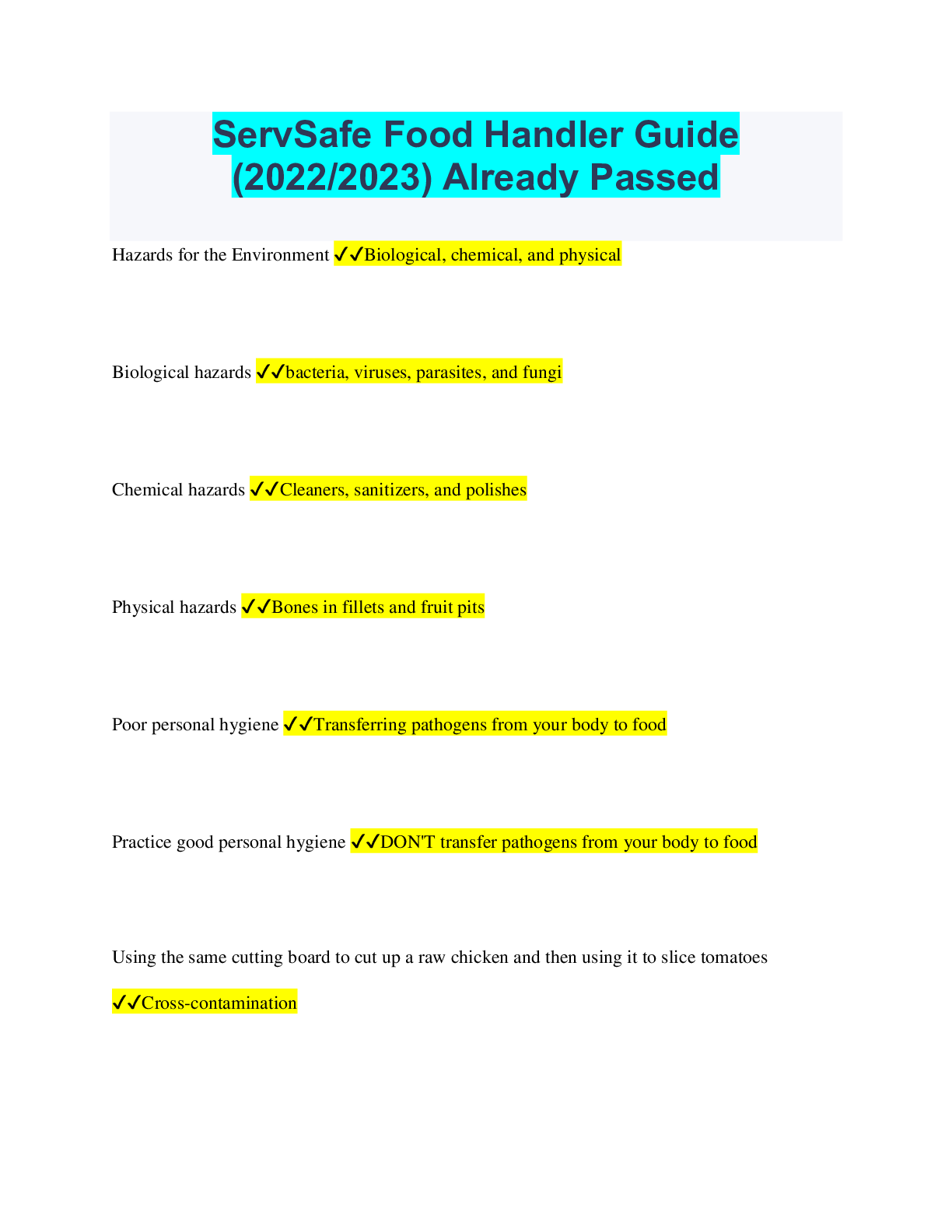
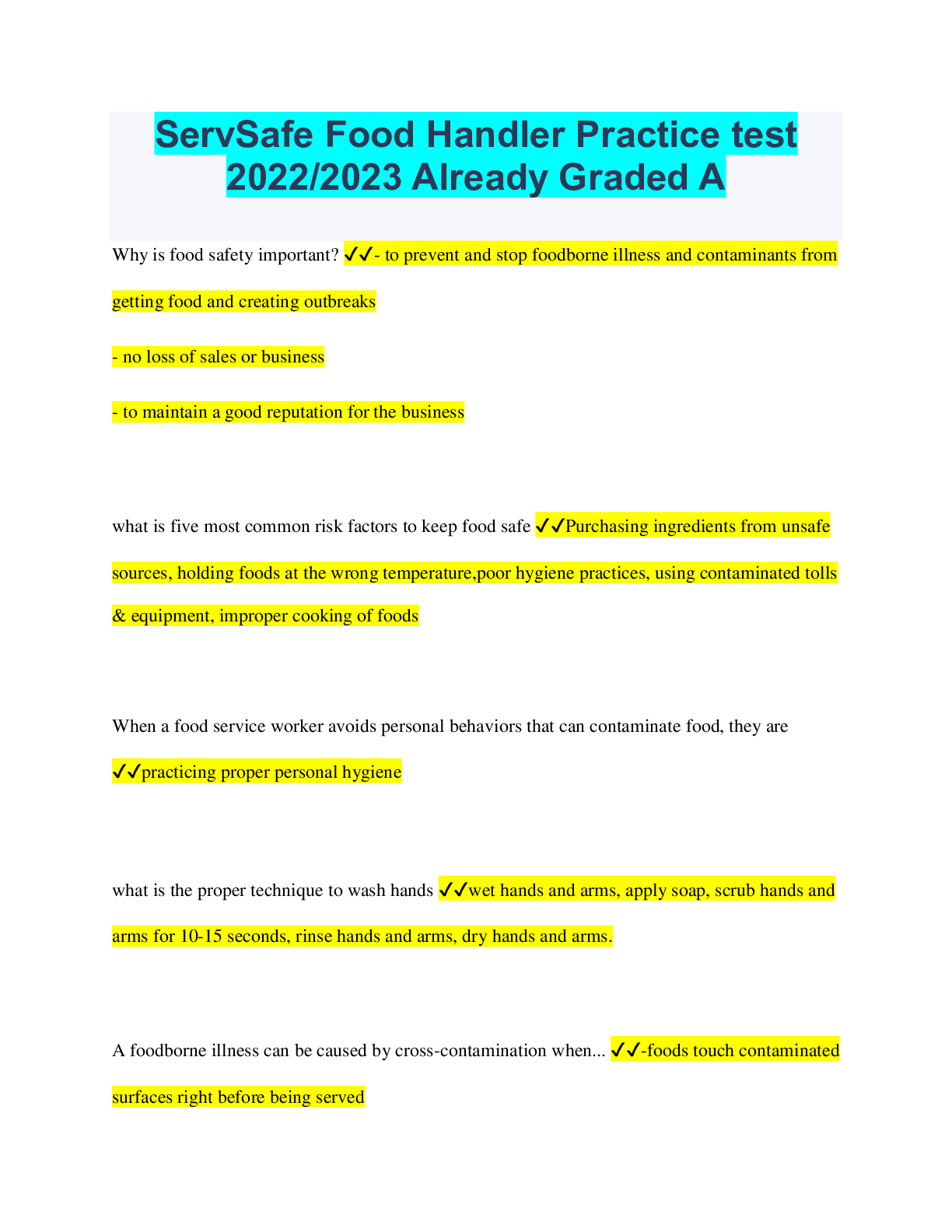

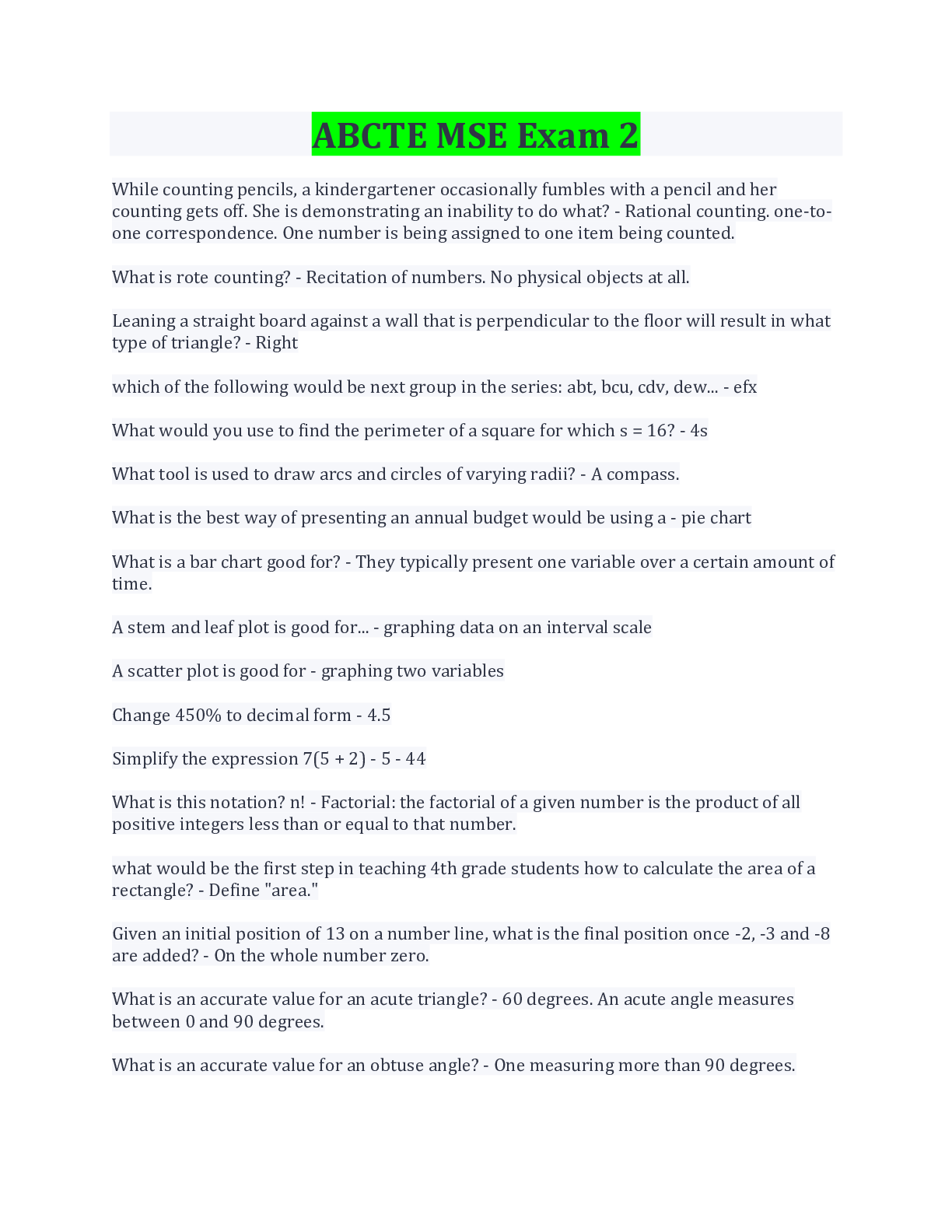

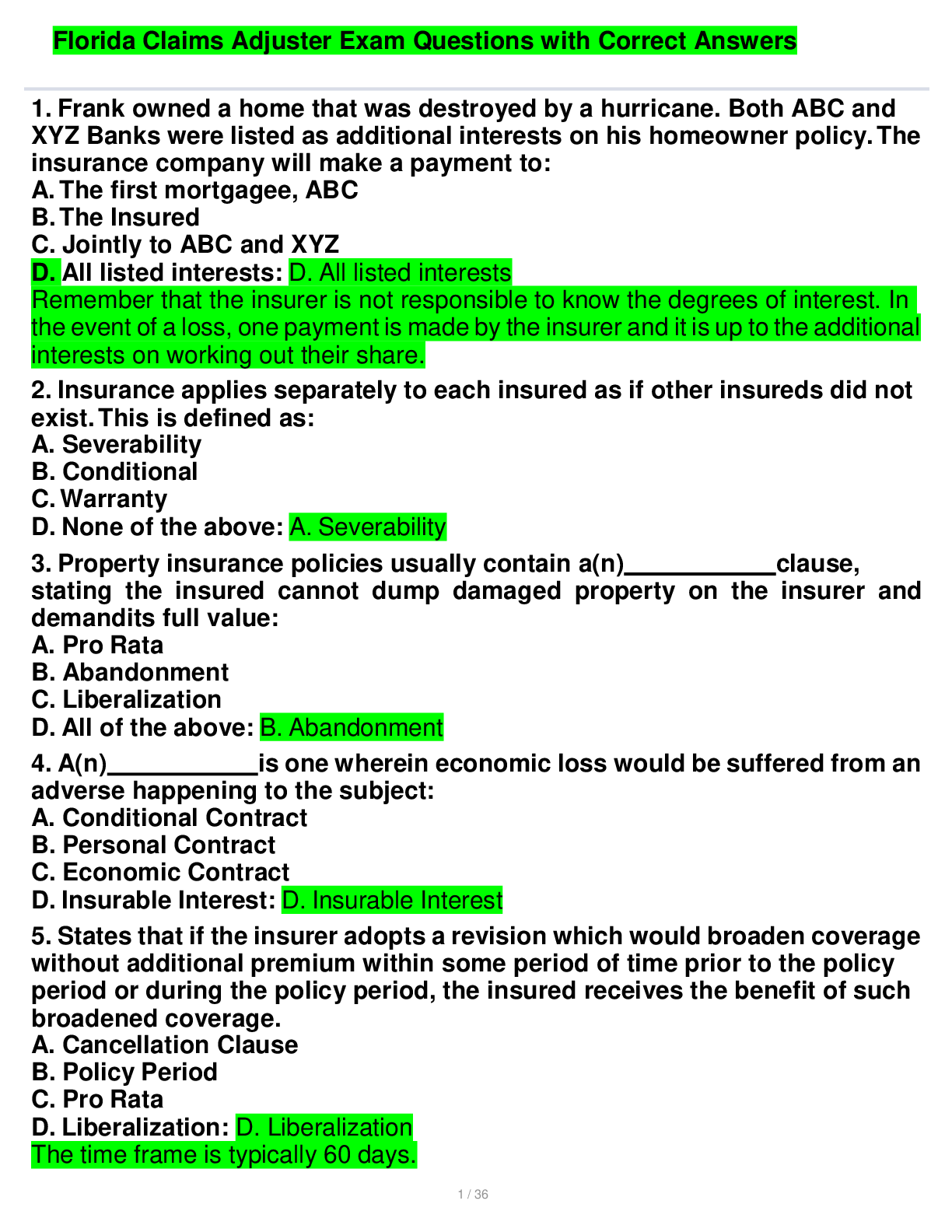
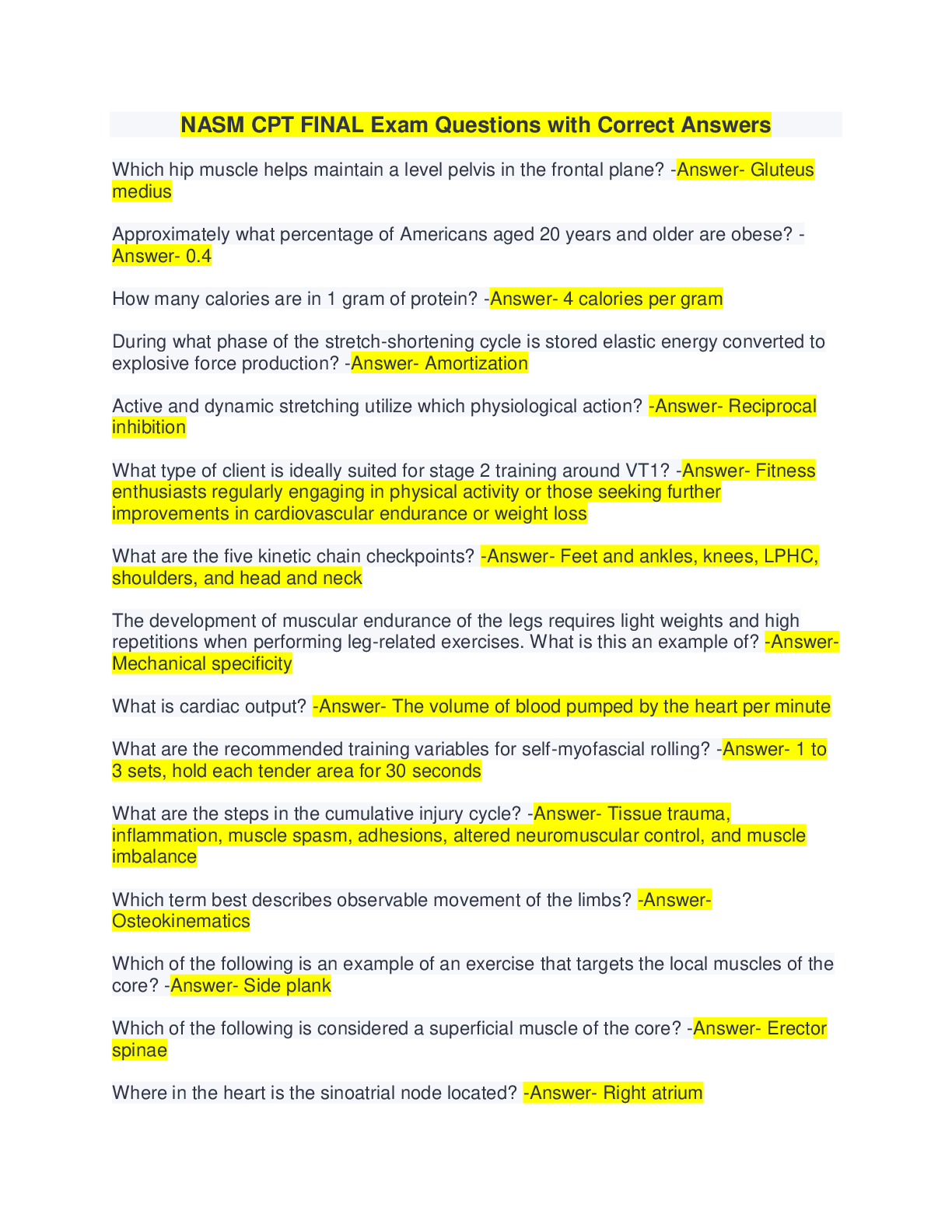



 Exam Preparation With Correct Answers Graded A+-1.png)
